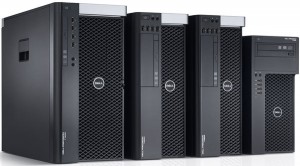 Dell has unveiled four new Precision workstations that have been designed for maximum upgrade flexibility. The Precision T range workstations take nVidia Quadro graphics cards and run on Intel Xeon E5-2600 processors, but differ from other workstations in the extent to which the user can reconfigure their hardware. A ‘split chassis’ system allows hard drives, power supply, optical drives and graphics cards to be swapped at will.
Dell has unveiled four new Precision workstations that have been designed for maximum upgrade flexibility. The Precision T range workstations take nVidia Quadro graphics cards and run on Intel Xeon E5-2600 processors, but differ from other workstations in the extent to which the user can reconfigure their hardware. A ‘split chassis’ system allows hard drives, power supply, optical drives and graphics cards to be swapped at will.
The Precision workstations range from a ‘single socket’ Precision T1650 reduced-height tower that can take four hard drives and a nVidia Quadro card to the mighty T7600, which can accommodate up to eight hard drives and as much as 512GB of quad-channel memory.
While all except the T1650 model in the new Precison range can take a pair of nVidia Quadra 6000 graphics cards, the top end T7600 also takes a pair of Tesla C2075 companion processors and a power supply unit rated at 1300 Watts to deal with the additional heat generated by the 600 Watt cards.
Dell and nVidia worked closely on both the development of the graphics card company’s Maximus technology – which allow a workstation to simultaneously render a scene while the user works on other editing or computational tasks – and on the new Precision models that make use of it.
Engineering company Parametric Solutions Inc, one of the clients Dell asked to test the T7600 ahead of its launch, reported that using the workstation they were able to perform CAD/CAM and other computational tasks in parallel and that the achieved modelling speeds took up to a quarter of the time as on their other workstations.
Adam Watkins, graphics supervisor at Pixomondo, which produced the 3D video effects for Martin Scorsese’s Oscar-winning Hugo animation, said Dell Precision workstations were crucial to his company’s ability to deliver the fully composited scenes just a day after they had been shot.
As well as hot-swappable hard disks, memory and graphics cards, the Precision workstations have interchangeable power supply units. This means that if a user needs to install a more powerful graphics card due to a particularly GPU-intensive rendering task, they can also swap the power supply for a more powerful one to ensure optimum system cooling and overall efficiency.
In order to make so many components hot-swappable, Dell has designed a new interior layout that can accommodate multiple hard drives and a combination of solid state drives and hard disks. The top of the range Dell Precision T7600 model has a removable top cover that allows a rack mount-like set of swappable hard drives to be replaced in seconds. Other models in the range also have hot-swappable hard drives but front-facing ones rather than top-loading. Up to four 3.5in hard drives or eight 2.5in drives can be fitted.
Such vast quantities of storage are needed in industries such as studio animation and rendering which generate terabytes of footage. Fast data transfers are also critical. The hot-swappable drive setup allows graphics professionals to download high-definition video that had just been shot to a workstation for editing and processing.
To ensure none of the footage is lost, Dell has developed a BIOS-based solution it terms ‘reliable memory technology (RTM)’ that monitors any bad memory sectors, tags it and remembers that portion for next time. It then avoids using that part of the memory. Should a particular memory sector be flagged up in this way seven times, the user will get a message advising them to inform an IT administrator that a new DIMM may be needed. In this way, Dell hopes to minimise downtime for designers. Any loss of focus and flow can interrupt creativity as well as productivity.
Dell designed the new Precision workstations with the help of current customers, tailoring the chassis design to their stated needs. Kirk Schell, vice president of Computing Products, Dell, said the easy customisation, chassis design and memory checking were the result of “hundreds of customer conversations”.
Don Maynard, Dell’s senior product manager for Precision workstations, told Digital Arts that handles were the number one requested feature of the new range of workstations. The company spent between three and four years developing the new chassis, while the Precision workstation range itself is now in its fourth iteration.
Three of the four new Dell Precision workstations, the T3600 , T5600 and T7600, will go onsale worldwide in May, with the entrylevel T1650 also planned for launch in May but likely to be a week or two after its stablemates. Dell cites pricing of between $1099 and $2399.





